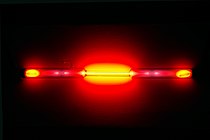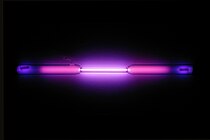
Back Edelgasse Afrikaans Gas noble AN غاز نبيل Arabic غاز نبيل ARY Gas noble AST Təsirsiz qazlar Azerbaijani نجیب قاز AZB Затлы газдар Bashkir Gas mulia BAN Інертныя газы Byelorussian
| Noble gases | |||||||||||
|---|---|---|---|---|---|---|---|---|---|---|---|
| |||||||||||
| ↓ Period | |||||||||||
| 1 | Helium (He) 2 | ||||||||||
| 2 | Neon (Ne) 10 | ||||||||||
| 3 | Argon (Ar) 18 | ||||||||||
| 4 | Krypton (Kr) 36 | ||||||||||
| 5 | Xenon (Xe) 54 | ||||||||||
| 6 | Radon (Rn) 86 | ||||||||||
| 7 | Oganesson (Og) 118 | ||||||||||
|
Legend
| |||||||||||
The noble gases (historically the inert gases, sometimes referred to as aerogens[1]) are the members of group 18 of the periodic table: helium (He), neon (Ne), argon (Ar), krypton (Kr), xenon (Xe), radon (Rn) and, in some cases, oganesson (Og). Under standard conditions, the first six of these elements are odorless, colorless, monatomic gases with very low chemical reactivity and cryogenic boiling points. The properties of the seventh, unstable, element, Og, are uncertain.
The intermolecular force between noble gas atoms is the very weak London dispersion force, so their boiling points are all cryogenic, below 165 K (−108 °C; −163 °F).[2]
The noble gases' inertness, or tendency not to react with other chemical substances, results from their electron configuration: their outer shell of valence electrons is "full", giving them little tendency to participate in chemical reactions. Only a few hundred noble gas compounds are known to exist. The inertness of noble gases makes them useful whenever chemical reactions are unwanted. For example, argon is used as a shielding gas in welding and as a filler gas in incandescent light bulbs. Helium is used to provide buoyancy in blimps and balloons. Helium and neon are also used as refrigerants due to their low boiling points. Industrial quantities of the noble gases, except for radon, are obtained by separating them from air using the methods of liquefaction of gases and fractional distillation. Helium is also a byproduct of the mining of natural gas. Radon is usually isolated from the radioactive decay of dissolved radium, thorium, or uranium compounds.
The seventh member of group 18 is oganesson, an unstable synthetic element whose chemistry is still uncertain because only five very short-lived atoms (t1/2 = 0.69 ms) have ever been synthesized (as of 2020[update][3]). IUPAC uses the term "noble gas" interchangeably with "group 18" and thus includes oganesson;[4] however, due to relativistic effects, oganesson is predicted to be a solid under standard conditions and reactive enough not to qualify functionally as "noble".[3]
- ^ Bauzá, Antonio; Frontera, Antonio (2015). "Aerogen Bonding Interaction: A New Supramolecular Force?". Angewandte Chemie International Edition. 54 (25): 7340–3. doi:10.1002/anie.201502571. PMID 25950423.
- ^ "Xenon | Definition, Properties, Atomic Mass, Compounds, & Facts". Britannica. 28 November 2023. Retrieved 12 January 2024.
- ^ a b Smits, Odile R.; Mewes, Jan-Michael; Jerabek, Paul; Schwerdtfeger, Peter (2020). "Oganesson: A Noble Gas Element That Is Neither Noble Nor a Gas". Angewandte Chemie International Edition. 59 (52): 23636–23640. doi:10.1002/anie.202011976. PMC 7814676. PMID 32959952.
- ^ Koppenol, W. (2016). "How to name new chemical elements" (PDF). Pure and Applied Chemistry. DeGruyter. doi:10.1515/pac-2015-0802. hdl:10045/55935. S2CID 102245448. Archived (PDF) from the original on 18 December 2023.




